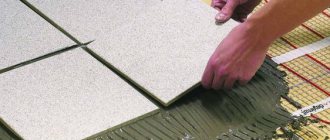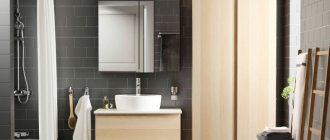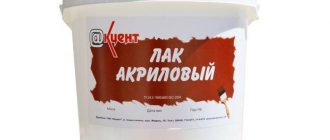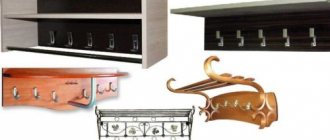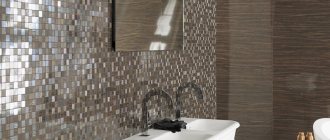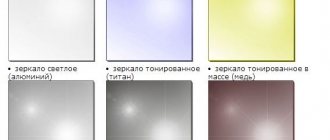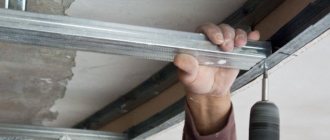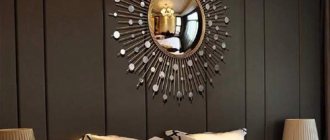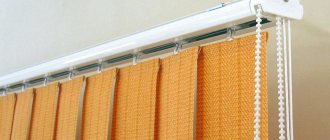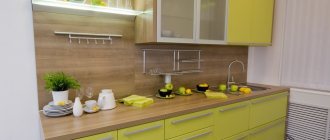Today it is impossible to imagine a house or apartment without mirrors. Products are installed in bedrooms and living rooms, bathrooms, even in the kitchen! They can have a frame and legs and be placed on the floor or table, or they can be a canvas mounted on the wall. A mirror on the wall can be framed or without one. Attaching the product in a frame to the wall is not difficult. Nails are driven into the surface or screws are screwed in and a frame with a mirror is hung on them. How to fix a product without a frame on a vertical surface? Obviously, such a wall mount for a mirror must be as strong as possible in order to withstand the weight of the product.
DIY fastening
When purchasing a product, carefully inspect it for elements of distortion and defects.
It should be smooth, without stains or scratches. Pay attention to the fastening fragments, if any. Before purchasing, choose a place in the apartment where it will hang. The mount itself is usually installed so that it is not noticeable. Do-it-yourself installation does not require special skills; all existing methods can be performed independently. The most common and familiar method is on nails. But they leave a mark in the wall, and later, if you remove the mirror, the hole will need to be sealed. Some people prefer the painting method: they are attached to the surface using a special thread.
When installing, you need to act carefully so as not to damage the surface of the mirror.
How to choose a mirror correctly?
To ensure that the reflection pleases you, and the piece of furniture itself meets all the requirements of room decor, choose wisely:
- thickness – at least 5 millimeters, otherwise the image will be distorted;
- the amalgam on the reverse side should be applied evenly, without scratches or thin areas;
- the mirror part should be smooth. No bubbles, chips or cracks are allowed;
- when choosing a place for fastening, take into account the fact that the reflective part should not touch doors and furniture - pencil cases, cabinets, open shelves;
- aluminum amalgam is cheaper than silver-plated, but it is less practical to use. So, condensation appears on it when the temperature changes. Therefore, for the bath and kitchen, choose silver amalgam; for other rooms, aluminum can be used.
Mounting a mirror with silver amalgam is preferable. than with aluminum. Although the latter is cheaper, it also has a much shorter service life.
Mounting methods
There are several different methods:
- Glue.
- On special holders.
- For self-tapping screws to a furniture door or for fastening with a plastic compensator.
- Using a decorative profile.
- There are silt nails on the dowels.
Installation recommendations:
- In a room where there is little light, place a mirror opposite the window. It will make it lighter;
- a large canvas will visually expand the room;
- It is not advisable to place it in the kitchen near the stove;
- in the children’s room it is better to cover the mirror with a protective film; if it breaks, no one will get hurt;
- It is convenient to place a full-length canvas in the hallway;
- The direction of the light should not be direct, otherwise the canvas will quickly fade.
Installation without drilling
The fastest installation method without drilling the wall is adhesive. It is reliable, convenient and uncomplicated. You only need to use special glue. It is sold in hardware stores and resembles liquid nails. The solution is applied to the back of the mirror and it is mounted on the wall. Recommendations must be followed:
- Only a flat surface is suitable for mounting. If the wall has defects, then the product will be in a stressed state and may eventually burst;
- This method of fastening is not suitable for glossy surfaces or in the bathroom, because it is not resistant to moisture and will begin to peel off over time.
With the adhesive method, it is no longer possible to completely remove the wall product. It is necessary to split it and dismantle it in parts.
Choose high-quality glue, the famous ones, “Bison”, “Ravak”.
How to hang a mount on dowels
To install the canvas using a dowel, you need to drill a hole in the product itself. It's not easy, you need to have some skills. You can contact a specialist, or sometimes they can make a hole right in the store upon purchase. Further:
- At home, attach the canvas to the desired surface, make marks at the attachment points. Using a drill, select a nozzle for concrete, make a hole up to ten millimeters deep and secure the sleeves.
- Next, apply the mirror and screw in the metal screws.
- Install the clamping elements.
- Plugs are placed on top.
After finishing work, check all elements for strength. Everything must be sustainable.
If the work is performed on a surface decorated with plasterboard, then you need to use special butterfly dowels. They have longitudinal ribs that prevent the dowel from turning, and a locking bolt holds it in place and prevents the fastening from falling into the wall.
Butterfly dowels are used for mounting products weighing up to twenty kilograms.
Using the same scheme, the canvas is attached to a fishing line or rope. First, dowels, anchors or hooks are installed, and then suspended.
How to attach without nails
You can attach a mirror sheet to the wall without nails.
You can use special liquid nails or special double-sided tape if the canvas is not heavy. If you choose adhesive tape for installation, it is better if its width is ten or fifteen centimeters.
The work is simple: liquid nails and adhesive tapes are applied to the back of the mirror at a distance of five to seven centimeters from each other. It is necessary to make indents from the edges so that when pressing the solution does not come out. Press for ten minutes. Prepare supports in advance to hold the mirror while it is fixed to the wall.
If you need to install the door leaf on the door, it is better to remove it from its hinges and place it horizontally for ease of installation.
The adhesive method is not suitable for surfaces decorated with wallpaper. There is no guarantee that they will hold the product.
It also cannot be glued to tiles. When renovating, leave space for it in advance.
Nuances of work taking into account the type of surface
There are several types of wall surfaces on which mirrors can be attached:
- concrete;
- drywall;
- brickwork;
- PVC panels;
- tile.
Criteria for choosing lighting for a bathroom mirror, connection rules
When installing a mirror on a wall, preliminary preparation is required. The choice of fixation method depends on the type of surface on which the canvas needs to be fixed.
| Surface type | Method of preparation | Mounting type | Tools, materials | Surface strength, mirror weight |
| Concrete | Coat with primer | Glue, sealant | Hammer, primer, glue, sealant, construction gun | Lasting, weight - 8–10 kg |
| Drywall | Clean from dirt and dust | Anchor bolts, butterfly dowels | Drill, screwdriver | Fragile, maximum weight - 20 kg |
| Brick | Coat with primer | Glue, sealant | Hammer, primer, glue, sealant, construction gun | Durable, medium weight |
| PVC panels | Installation of sheathing | Glue, tape | Glue, sealant, construction gun | Lightweight models, as the surface is fragile |
| Tile | Clean from dirt and dust | Dowel screw, glue, sealant | Concrete drills, electric drill | Not very heavy, medium surface strength |
The mounting method is selected based on the design, weight of the product, as well as the type of wall
A light mirror can be glued to a flat wall with liquid nails
You can hang a mirror on a plasterboard wall using a butterfly dowel
Rules for determining mirror installation height
How to fix a mirror canvas without a frame with your own hands
Canvas without a frame can be secured in several ways:
- Glue. The working technique is the same as with mirrors with a frame: prepare the surface, level it, remove dust, make markings and install. This method is suitable for partially decorating a wall.
- Profile. The canvas is inserted into a metal profile. This makes it convenient to decorate large surfaces. Working technique: prepare the surface, install the profile, apply a silicone seal to the edge of the glass so that the mirror fits into the grooves more easily. The canvas is inserted and pressed to secure it. All other parts are installed by analogy.
Fittings and profile for mirror
Mounting a mirror on a wall can be done using different clamps, strips and profiles.
The elements are made of chrome-plated and stainless steel, plastic and silicone. All fasteners have restrictions on the weight of the product.
If the mirror is without a frame, then you can use various types of fittings available in stores: brackets, profiles, brackets, clamps and strips.
Using connectors, bushings and washers attached to the base, you can create a mirror wall. Silicone and plastic holders do not require drilling holes, are attached pointwise and are held on with sealant, but are only suitable for small models and decorative shaped elements.
With their help, the mirror can be attached either close to the wall or placed remotely - with a gap of 5 mm to several centimeters between it and the wall.
Types of holders for installation:
- Hardware, for mounting which you need to make several holes in the wall. First, the fittings are fixed to the canvas, the fixation points are marked, a hole is drilled, and the mirror element is fixed using plastic dowels. The holders are made for different widths of the canvas; they can be located close to the wall or with a small gap. The attachment point is closed with a decorative plug.
- Profile, when a metal strip is attached to the canvas, and the product is hung on it using hooks and brackets, which are fixed to the canvas with glue or liquid nails. This installation method is invisible and leaves a gap between the surfaces, which prevents the appearance of mold in damp rooms and damage to the internal coating of the mirror.
- Cabinet-type, when a sheet of plywood or plasterboard is attached to the back surface using sealant, which ensures better adhesion to the base. The material is cut out at a distance of 3-5 cm from the edge of the canvas, fixed and hung on the wall using tape, glue or hanger.
Pay special attention to the lower fasteners - they must withstand the greatest load.
When choosing fittings for attaching a mirror to a wall, it is necessary to base it on several criteria - this is minimal disruption of the surface during installation, the strength of the elements, it is advisable to choose from metal with dowels included, and invisibility; the more massive the fastener, the more difficult it is to organically combine it with the canvas without a frame.
It is possible to install the fittings in which the fasteners are installed at the bottom and top, and the mirror is “nested” on the side.
Installing large mirrors: features and recommendations
It is better to entrust the installation of large mirrors to a specialist, as this requires skills. The installation method depends on the size and characteristics of the canvas. The main method of fastening is using hardware and special fasteners.
Sometimes the adhesive method, tape or decorative screws are used. When choosing materials for fastening, give preference to reliable and trusted manufacturers.
Recommendations:
- Use glue that has not expired.
- Do not touch the mirror for several days until it is completely fixed.
- Prepare the surface correctly: level and eliminate defects.
- Secure a heavy mirror additionally mechanically. You can add small fasteners or make a small stand.
Mirror holders
Quite often, mirrors are hung on the wall using special devices. This includes various brackets and clamps.
These fabric holders come in two types:
- Through. They are used if the canvas already has a corresponding hole. Essentially, these are the same self-tapping screws, but only with decorative overlays. They come in various shapes and sizes.
- Non-through. Holders of this type are attached both to the cabinet door and to the wall, and the mirror is already fixed through the edges. They can be attached tightly or left a small gap (the second option is especially suitable in the case of curved walls).
Various options for mirror holders
In our special article you can learn how to glue a mirror to a cabinet door.
Such devices have the following advantages:
- they can be installed in any room using mirror sheets of various sizes;
- such fasteners have maximum stability and are “indifferent” to temperature changes and high air humidity;
- if necessary, the mirror can be dismantled without any damage;
- Clamps and brackets are easy to attach to any surface.
The only disadvantage is the cost of fasteners, which will be higher than that of glue or double-sided tape.
Installation features: step-by-step instructions
Installing a mirror using such auxiliary fittings is extremely simple. Any person can handle such actions if desired.
Step 1. First of all, you should mark the installation locations of these fasteners on the wall. It is important to take accurate measurements here, otherwise you will not be able to hang the canvas evenly. Usually, two fasteners are fixed at the bottom, two at the top in the corners, one on both sides. Moreover, if the mirror is too voluminous and heavy, then more fasteners will be needed.
We put markings on the wall
Step 2. Next, you need to drill holes along the marks left. It should be remembered that they should be slightly larger than the dowels themselves.
Drilling holes for dowels
The dowels must be inserted into the holes, and then the fasteners must be secured to them.
We fix the mirror on the holders
Step 3. The final step is to hang the mirror on the holders. If the mirror is held unsteadily, then at this stage you can immediately adjust the fasteners. Then decorative plugs are attached to the clamps.
Prices for the range of drills
Drill
Video - Hanging a mirror in the bathroom
What is a mirror
In production, sheet glass is used, obtained from a mixture of sand, soda, limestone, and other materials. They must contain a minimum amount of iron salts, which impart unnecessary tints to the glass.
The modern glass mirror is familiar to everyone and is a sheet of polished glass, on one side of which a thin layer of metal called amalgam is sprayed.
The initial mass is boiled, fired, shaped into sheets, polished, and cut using diamond rollers. A metal coating is applied to make the surface reflect light and protected with varnish.
Aluminum is used in the manufacture of budget mirrors, and silver – in expensive ones.
When choosing a finished product, take into account the thickness of the glass, the quality of the coating on the reverse side - uniformity, absence of stains and other defects. They take into account the degree of distortion of the display - it happens that the mirror “fattens” or “slims” - choose according to your taste.
In everyday life, it satisfies a person’s physiological need to see himself, and is an element of the interior that allows him to change the perception of space.
There’s a place for everything: where to hang a mirror
It is difficult to create an ideal Feng Shui home in a metropolis. To do this, you need to build it yourself, focusing on the cardinal points, and demolishing a couple of neighboring buildings. However, you have the power to make your home harmonious, attract good luck to the hallway, health to the kitchen and love to the bedroom. The placement of the mirror in the hallway according to Feng Shui plays an important role in this.
Modern oval mirror for the hallway
Dancing from the threshold: where to hang a mirror in the hallway
The main flow of qi energy, like a person, enters the house through the door. Therefore, special attention should be paid to the design of the entrance area. It should be clean, well lit, and not overloaded with unnecessary things and shoes. It’s great if the front door is red, although it’s more important to understand where exactly to place the mirror in the hallway.
The main mistake in placing a mirror in the hallway according to Feng Shui is to hang it directly opposite the front door. It will reflect all the positive energy entering the house and return it back. It is better to place a reflective surface on an adjacent wall, and in front of the entrance place a console table, ikebana, a vase of flowers, or choose a model in a fashionable frame with tropical plants.
Suitable here
×
Rectangular mirror in a wide frame with Tropic print
16 500 rub.
RUB
14,850 buy
Rectangular mirror for the hallway in a frame with a fashionable print
Designers agree with the eastern sages on where the mirror should hang in the hallway. The reflection opposite the door creates an unpleasant psychological effect, as if another figure is moving towards the person entering.
Taking into account the layout: mirror in the hallway according to Feng Shui
Narrow and long corridors into which several doors open at once are a problem for the circulation of qi energy. In them, it accelerates in a straight line, turning into a negative antipode, and the doors introduce additional confusion into this process. Mirror crystals, discreetly suspended from the ceiling, paintings and rugs located at certain intervals will help smooth out the negative effect. Try to visually divide a long and narrow space into parts. Hanging a mirror in the hallway opposite the door is also not a good idea.
Solutions for a small hallway
Classic Feng Shui is designed for large rooms. It is believed that they favor cash flows, and only modest amounts can linger in small rooms. For a small hall, use medium-sized mirrors, use cabinets with mirrored doors and carefully choose where it is better to hang a mirror in the hallway and corridor.
Narrow mirrored cabinet for a small hallway
Important:
at what height should you hang a mirror in the hallway? Its upper edge should be at a height of 200 cm from the floor and above.
What's opposite the mirror? Where not to hang a mirror
The main task of a mirror is to reflect. Therefore, the common belief that mirrors visually enlarge the space is only partly true. If a dark corridor, a mess or a bathroom is reflected in the mirror, the mirror will not bring any additional light, air or positive vibrations and will increase the existing negative. When choosing where to hang a mirror in the hallway, consider the reflection factor.
How to hang a mirror in the hallway if it has a window? According to Feng Shui, just not in front of it, so as not to reflect positive energy back onto the street.
Beautiful mirror with flowers for a cozy hallway according to Feng Shui
Important:
the reflective surface must be in perfect condition, without dust, chips, damage to the amalgam and cracks. The point is not only in aesthetics, but also in the fact that positive energy does not linger on a dirty and spoiled surface.
On a brick base
For installation using glue, prepare the surface - if necessary, remove the wallpaper, carefully level it with a primer, followed by sanding. Be sure to clean it and wipe it with an alcohol solution.
Special glue intended for glass with amalgam coating is used according to the instructions. They are applied to the surface not in a continuous mass, but in parallel stripes at equal intervals or in “fat” drops in a checkerboard pattern.
Then the product is pressed tightly and held for about a day until it sets completely.
If, when deciding how to attach a mirror, this method is chosen, you need to remember that it will no longer be possible to remove or rehang it. This is the last place of its “stay” - then it can only be broken up and removed.
When using thick double-sided tape, the surface is prepared. It is glued on the back side of the glass along the perimeter and surface in vertical or horizontal stripes in increments of 5-7 cm. After which the protective film is removed from it and pressed into place.
All this can be easily done with your own hands.
The composition of liquid nails allows you to securely hang the mirror without damaging the decorative surface of the installation site. The strength of this construction adhesive is significantly superior to PVA glue, and some modifications are equivalent to the characteristics of dowels.
The option is very convenient, since there is no need for tools and fasteners, you only need suitable glue.
Important! Using adhesive tape, a product with an area of only up to 1 m² is installed; a larger one may simply fall off later.
Important! Despite the guaranteed strength of adhesive materials, when working it is better to use a combination of two methods.
The surface of the wall cleared for the mirror must be flat, otherwise the fastening will be unreliable.
Hardware is usually used to mount a mirror that has ready-made holes. To do this, you need to drill recesses in the wall along the diameter of the dowel used, 5 mm longer than the length of the self-tapping screw that you plan to use. After drilling, they are cleaned of dust, dowels are installed, the product is attached, and the screws are tightened one by one. Be sure to cover with decorative heads.
When hanging a mirror, you need to pay attention to the shape of the interior element.
Mirrors in the interior of the house – 50 photo ideas:
PreviousMirrorsMirror-sun: the advantages of creating a product with your own hands
Next
MirrorsMirror reflection of our desires in the bedroom
On tiled flooring
A practical option is to mount the mirror on top of the tiles using tape or glue. You can also dismantle the tile in the area where the product is intended to be placed and glue it in.
If the tile is already on the wall, then you should not try to glue the mirror.
There is no need to worry about the tiles cracking if the material used is of high quality.
A good option is to hang a mirror using hardware, making several drillings in the partition. To do this, you need to prepare a drill, a screwdriver, special tile drills, fastening brackets, and plastic dowels with screws.
It is necessary to drill holes in the tile and base.
Next, you can proceed in two ways:
- Make holes in the wall and the product, secure it with screws, after installing dowels and special rubber gaskets;
- Purchase and install original mirror mounts in the form of brackets that are fixed to the wall and support the product.
The number of fasteners is determined by the size and weight of the item. The larger the dimensions, the more staples are required.
How to determine the mounting height of mirrors
A mirror is a wonderful interior decoration. But in addition to aesthetic functions, it must cope with its direct responsibilities. It should be placed in such a way that none of the family members experience inconvenience or discomfort when using it. Of course, in personal rooms they need to be adapted to the owner. But general accessories - in the bathroom, living room or hallway should be comfortable for everyone.
The mirror in the bathroom should have a distance of 20-40 cm from the sink. This arrangement will provide it with reliable protection from splashes, and at the same time will contribute to comfortable use. A distance of 1m 20 cm should be left from the floor. This will ensure the safety of small children. The top edge should exceed the height of the tallest person in the household by a couple of centimeters. Consider these rules when choosing a mirror. They will help you decide on the size of the canvas.
In the hallway it is better to use a tall floor-length mirror. With its help, you can always adequately assess your appearance before leaving home. The height of the panel should be comfortable for the main “record holder” for height among your family members.
